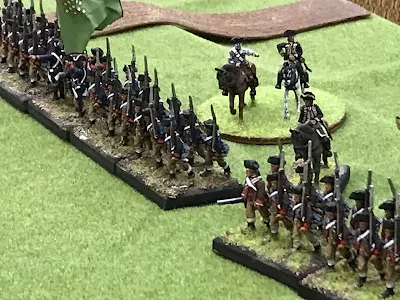In corresponding with Steve Haller he mentioned that he had fought Hanging Rock as a miniature Wargame. About twenty years ago he first put it on at Historicon and he kindly sent me his map, order of battle and scenario rules. It looked great so I am going to be running my game based on his. All credit should be directed to Steve Haller. This will give you a fun game with a wide range of unit types based on the Battle of Hanging Rock that captured the spirit and confusion of the battle.
All regiments are based on a 5:1 ratio of numbers per figures. Some units strengths have been fudged for playability. Rules used are Steve Haller's "Whites of Their Eyes" with 25mm miniatures. In the order of battle I list the units, how many figures in it and its morale rating. My table measures 6 feet x 5 feet. This just works but a slightly longer table would be much better. Game lasts 10 turns. Victory determined by most points at end of game.
 |
| Top of table is North. Bottom is south. Fields mark camps. |
British Command:
Major Carden' s command
Royal Artillery 3pdr. Elite
Prince of Wales American Regiment 30/regulars
Royal North Carolina Regiment 30/regulars
British Legion Infantry 20/lights
Colonel Bryan's command
Bryan's North Carolina Militia 30/militia
Rugeley’s South Carolina Milita 30/militia
The Loyalist Forces are set up in four camps widely spaced apart. From north to south on the table the camps are occupied by: 1st camp North and South Carolina Militia regiments, 2nd camp Royal North Carolina Regiment, 3rd camp British Legion Infantry and 4th camp Prince of Wales American and Royal Artillery.
To represent the surprise attack on the camps and the time needed to assemble the regiments on the first move of the game only the militia in the first camp can move. On the second turn of the game the rest of the Crown forces can move
Possible Reinforcements:
British Legion Dragoons 8/Cavalry
New York Volunteers 30/regulars
Historically a troop of the British Legion Dragons or mounted infantry arrived during the battle. In addition it was possible that the New York Volunteers from Rocky Mount could have also come out to help. On turn three of the game roll D6 for each of these units. They will arrive on the turn determined in road column formation on the road on the south edge of the map.
1 - 2 = turn 3
3 - 4 = turn 4
5 - 6 = turn 5
Victory Conditions: by the end of the game on turn 10
A. Inflict maximum casualties on enemy. 1point for each enemy unit under 50% and 2 points for each enemy unit routed.
B. Hold camp. Must be held by at least one stand and not in melee. Each camp held is 2 points.
American Command:
General Thomas Sumter field commander
Col. Irwin's North Carolina Brigade
Col. Davie
Davie's NC Horse. 8/cavalry
Davie's NC Rifles. 18/rifles
Col. Irwin
1st NC Militia. 30/militia
3rd NC Militia 30/militia
Col. Hill's South Carolina Brigade:
Col. Hill
Hill's South Carolina Horse 8/militia horse
Catawha Indians 4/lights
SC State Infantry 18/lights
2nd SC Militia 30/militia
3rd SC Militia 30/militia
Set Up:
The Patriot forces will move first each turn. On the first turn Davie's horse and rifles set up 6" from the table edge in the north west corner. Irwin's command set up 6" from the table edge on the northern table in the woods in the center.
On the second turn each unit of Hill's command rolls a d6 to see where they enter the table. Section 1 is north east corner, 2 is center Northern edge, 3 - 4 is 12" south of north east corner and 5 - 6 is 24" south of north east corner.
Possible Reinforcements:
Continental Artillery light gun/regular
Maryland Continentals 18/regulars
Although there were no historical reinforcements during the battle If you wish you could have a possible group of Continentals from Gate's army. Historically Gates did detached a small force of Marylanders and a gun. If you want to add this command they will enter on the north east road in road column. Roll D6 on turn four. On a 1,2 or 3 they arrive on turn 4 otherwise they arrive turn 5.
Victory Conditions: by the end of the game on turn 10
A. Inflict maximum casualties on enemy. 1point for each enemy unit under 50% and 2 points for each enemy unit routed or artillery stand captured.
B. Capture enemy camp. Must be held by at least one stand and not in melee. Each camp captured is 2 points.
Note: Patriot units that capture a camp must roll D6. If a 4,5 or 6 they carry on and continue fighting as normal. Otherwise unit is out of the fight being too busy pillaging and getting drunk from captured supplies and taking there ilk gotten goods home!


























